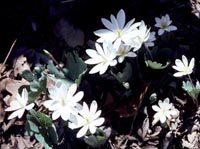Resource Library
Plant of the Week: Bloodroot
The University of Arkansas System Division of Agriculture does not promote, support or recommend plants featured in "Plant of the Week." Please consult your local Extension office for plants suitable for your region.
Plant of the Week
Bloodroot
Latin: Sanguinaria canadensis

My favorite flower is a moving target, but this week’s favorite is bloodroot. This
delicate little wild flower is one of the plants that ushers in spring in late winter
and then fades quietly away as the heat of summer arrives.
Bloodroot is aptly named. It has thick rhizomes that are about the size of your finger.
When the root is cut, the stem exudes a red sap that looks just like blood. In fact,
when I was first given a division of the plant, the playful gardener held up a dirty
hand with a stub of root protruding between her fingers and declared "Oh! I’ve cut
off my finger!" I must admit I have stolen her line for every plant I’ve given away
since then.
This early spring plant is distributed in the eastern states from Canada to East
Texas where it grows in moist, open woods. It typically is found in Arkansas on north
slopes where the heat of summer is delayed as long as possible. It appears as a single
stem protruding from the leaf litter with the flower bud encircled in the rolled leaf
like a Mexican chalupa protecting refried beans. The white flower is about two inches
across with from eight to 10 petals.
Numerous yellow stamens crowd the center of the flower. The blooms only last a few
days but when they appear they are like a late spring snow blanketing the ground.
There is only one leaf per flower. The gray-green leaf grows about six inches above
the ground and is a curious affair with an overall round shape with deep rounded lobes.
The leaves die down after the seeds are dispersed in early summer.
Bloodroot is a member of the poppy family and is listed as a poisonous plant, even
though no reports of human or animal poisoning have been reported in the United States.
The toxic principle is an acrid alkaloid called sanguinarine An extract from the roots
was used in various herbal remedies in bygone days and was even tested as an anti-cancer
drug. The American Indians called the plant red puccoon and used the juice from the
roots for war paint.
No woodland garden is complete without a bloodroot colony. Site the plants in a scattered
planting where the roots will not be disturbed and pretty much forget them. They will
continue to flower and produce seed every year, increasing the size of the colony
each year. For the real plant collector, a double flowered form is available which
has blooms that look like a miniature waterlily. The plant seems immune to inset and
disease attack if well situated in the shade garden.
By: Gerald Klingaman, retired
Extension Horticulturist - Ornamentals
Extension News - March 31, 2000
The University of Arkansas System Division of Agriculture does not maintain lists of retail outlets where these plants can be purchased. Please check your local nursery or other retail outlets to ask about the availability of these plants for your growing area.